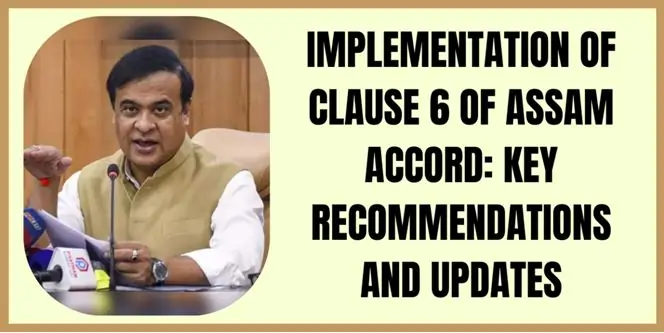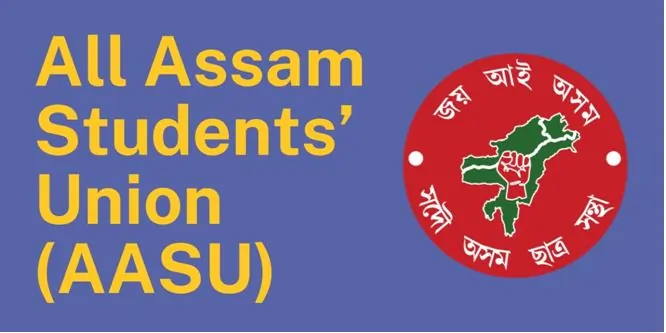
In recent times the authorities of Assam have initiated actions towards of the recommendations of the committee chaired by Biplab Sarma. The process was initiated when Sarma, the Assam’s Chief Minister, declared it during the meeting with the All Assam Students’ Union (AASU). In its report, the committee has suggested 67 measures and out of that, the state government has approved 52. Nevertheless, 15 major recommendations that need constitutional change cannot be adopted at the moment. These recommendations will be presented before the central government after sometime appropriately.Some of the accepted recommendation areas are definition of Assamese people, representation through reservation in legislative bodies and in government jobs and legal safeguards for ownership of land. The state government has also taken some fruitful measures to enlighten the Assamese culture and traditional values through various programs.
The Assam Accord of 1985 was an important agreement that was sought to be devoted to the question of influx in Assam. Clause 6 is also a fundamental part of this Accord because it is intended to protect the language, culture, and social structure of the people of Assam. This clause insists on constitutional, legislative, and administrative measures for the protection and furthering of the rights of the aboriginal people of Assam. Clause 6 has provoked controversy and generated much discussion over the years as an important measure degenerating into tyranny.
Background of Clause 6
This is contained in clause 6 of the Assam Accord which promises to accord constitutional, legislative and administrative protection to the cultural, social, linguistic identity and heritage of the Assamese people. This clause was inserted in the light of change in population ratio as well as to provide some solace to the native people of this region mainly due to entry of migrants from Bangladesh. The main purpose remains the protection of the identity of the Assamese people and preserving their indigenous identity in these circumstances.
Biplab Sarma Committee formation
The Union Home Ministry set up a 14-body panel headed by Biplab Kumar Sarma, an ex-Chief Justice of Assam High Court in July 2019. The establishment committee had to offer recommendations on how the Clause 6 would be implemented. Another problem was how to distinguish which people belong to the “Assamese people”, who will have an opportunity to enjoy the given protecting measures. About how exactly the committee worked and to whom it referred: the committee provided in its final report in February, 2020.
Key Recommendations
- Definition of Assamese People: It recommended that ‘Assamese people’ should only mean the indigenous tribes of Assam as well as other continued indigenous of Assam, Indian citizens who was settled in Assam before January 1, 1951, and their descendants.
- Reservations: Grounded on this definition, the committee advised that the Assamese people be given reservations in the Parliament, the Assembly, local government and state employment. This is intended for effective representation of indigenous people to key decision making forums.
- Land Rights: To safeguarding the privileges in the land of the indigenous people, the committee suggested certain limitations on the ability of the person or entity to transfer the land to the non-Assamese people.
- Cultural Safeguards: Some of such suggestions were to propagate and conserve the culture of the people of Assam with the help of culture houses and to encourage literature in the Assamese language.
The Accord was made in 1985 known as the Assam Accord which was a tripartite agreement between the Central Government, the Assam state Government and the political parties to solve the problem of the Illegal Immigration and its effect of the social and environmental life of Assamese people. The very clause 6 of the Accord ever emphasized the constitutional, legislative and administrative measures to be taken to protect the interest of the Assamese people. Clause 6 has been recently picking up the pace, and while the Assam government agreed to some recommendations of the panel, others are kept hanging. Lets look up on the some of the Neglected ones:
- Constitutional Amendments: Out of 15 primary recommendations which include constitutional changes, no action has been taken. They comprise provisions for more decentralisation for Assam, special legislative measure, and other constitutional protection. The government has said will be presented to the central government at the right time in the given recommendations.
- Implementation Mechanism: This particular aspect has not been implemented fully where the recommendation has been made that there should be a sound mechanism for putting into Effect Clause 6. This involves putting into place a specific mechanism to manage the implementation process as well as monitor and guaranty that the gains will get to the right consumers.
- Educational Safeguards: Execution-related recommendations focusing on educational protection measures like incorporation of history and culture of Assamese in educational curriculum and popularization of Assamese language in educational sector has not been followed in its entirety. Such steps are very important to safeguard the linguistic assimilation of the people of Assam.
- Health and Social Welfare: Health and social welfare recommendations including construction of health facilities and social security services for the indigenous people have not yet been met. These measures are sure to go a long way in enhancing the quality of life of the people of Assam.
Some of the Key Challenges associated are:
- Constitutional Amendments: The major problems in the implementation of Clause 6 of the Assam Accord include the requirement of constitutional changes. Some of the myriad proposals like Assam’s more autonomy and special legislative right are constitutional amendments and it cannot be done easily and promptly.
- Defining “Assamese People”: To the present date, there is no definite perspective on who exactly forms the Assamese people. On the one hand, the Biplab Sarma Committee that has given a definition for eligibility, there has been issues concerning the criteria’s ability to include more people and likelihood of future controversy.
- Political Will and Coordination: In view of this, extensive political will and synergy between the two-tier governments must be demonstrated when enforcing the rules. These shortcomings and the differences in political agendas mean that there is no definite position and movement.
- Resource Allocation: Sufficient resources are required to bring into effect the findings mainly on land issues, culture and other aspects of development. These efforts, however might be hindered by; Lack of adequate finances and other administrative facilities.
- Social Tensions: The destructive effect of Clause 6 may likely see in an increase of social conflict between the diverse communities in Assam. It is always tricky to make sure other groups do not feel left out.
Way Forward
- Collaborative Approach: Among these, focus is made on the state and centralized cooperation, as well as involvement of different stakeholders. It is crucial to establish a consensus to prevent any conformity issues hence constant meetings would provide a solution to problems.
- Phased Implementation: It is also advisable to feed back the recommendations through phases to avoid exhausting available resources in the initial phase only and to modify the implementation phase according to the feedback and results yielded. Implementing only the most important recommendations will help continue the process systematically.
- Strengthening Institutions: It is crucial to create sound institutions that will be responsible for the implementation process. This includes developing organizations to oversee the level of implementation, receipt of concerns and handling of complaints, and responsibility.
- Public Awareness and Engagement: Creating more awareness on the public on the goals of Clause 6 and demonstrating to them the value of Clause 6 can also assist to gain the support of the public and also decrease opposition. Organizational outreach can help establish a sense of ownership and build unity because the stakeholders involved are residents of the community.
- Addressing Social Concerns: Measures that will be taken to solve various social issues and enhance relationships between various groups of people are crucial. This comprises the need to avoid isolation of any group resulting from the advantages Clause 6 is likely to have.
Conclusion
It may also be said that the process of implementing Clause 6 of the Assam Accord is a complicated and continuing one. Although the Assam government has recently come out with its report of accepting and implementing various other important recommendations the implementation of Clause 6 still poses a major challenge in achieving its purpose. The constitutional amendments, a strong implementation mechanism, provisions of education and social welfare facilities remain two other important factors that cannot be overemphasized. It is thus, the endeavour of the state and the central governments, civil society organisations, activists, scholars and other related stakeholders to strive for the course of Clause 6 and safeguard the cultural, social and linguistic identity of the Assamese people.
All Assam Students’ Union (AASU)

It is a well-known student association in Assam, recognized for its important place in the social and political affair of the state. Formed on August 8, 1967, AASU has been involved in several movements that sought to safeguard the rights and identity of the indigenes of Assamese community.
Historical Significance
All Assam Students’ Union(AASU) got the national importance during the Assam Movement 1979-1985 against the influx of foreigners particularly from Bangladesh. AASU spearheaded the movement to identify, exclude and deport all the immigrants who have entered Assam on the pretext of employment to maintain the demography of the state. This led to signing of the Assam Accord in the year 1985 between the Government of India, Assam state government and many leaders of AASU.
Objectives and Activities
AASU main aim is to protect the cultural, social, and Linguistic self-identity of the Assamese community. The activities that have been carried out by AASU over the years: protests, awareness creation, and consultations with appropriate government authorities. The organisation has also had a serious role in the execution of the Assam Accord, primarily Clause 6 which is aimed at granting constitutional, legislative and administrative protection to the original inhabitants of the state.
Recent Involvement
More recently, AASU has been quite prominent in protests against the Citizenship Amendment Act (CAA) as it violates the Assam Accord in the AASU view as it grants citizenship to illegal immigrants on the basis of their religion. AASU, like other regional bodies, has come out on roads and courts against the CAA.
Future Prospects
AASU remains today still an active factor in the socio-political life of Assam. The obligation of the organization to safeguard the rights and self-identity of the Assamese people still stays inviolable. Given the demographic dynamics and political issues that Assam is facing, AASU’s role in representing the interest of the indigenous people will be instrumental in future development of the state.